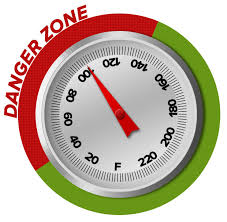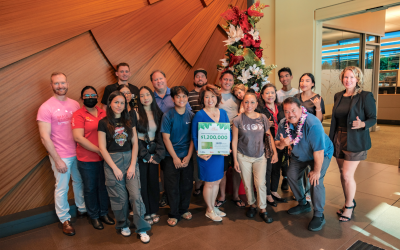 Rapidly cooling TCS food (food that needs time/temperature control for safety) is important to prevent the potential for growth of bacteria as it passes through the danger zone. To ensure minimal bacterial growth as the food cools it must cool from 135° to 70° in 2 hours, and it must get to 41° in a total of 6 hours or less. Also, food that has warmed up during prep (slicing, portioning, etc.) must be re-cooled back to 41° quickly. I recommend keeping cooling logs to make sure that the food is checked for temperature at the 2 hour mark. If it is not at 70° or below you must take immediate corrective action. Sample cooling logs were given to every restaurant by the DOH in their packet of “How to Get a Green Placard” in 2014, and can be found on their website, http://health.hawaii.gov/san/files/2013/05/cooling-temperature-log-black-white-logo.pdf.
Rapidly cooling TCS food (food that needs time/temperature control for safety) is important to prevent the potential for growth of bacteria as it passes through the danger zone. To ensure minimal bacterial growth as the food cools it must cool from 135° to 70° in 2 hours, and it must get to 41° in a total of 6 hours or less. Also, food that has warmed up during prep (slicing, portioning, etc.) must be re-cooled back to 41° quickly. I recommend keeping cooling logs to make sure that the food is checked for temperature at the 2 hour mark. If it is not at 70° or below you must take immediate corrective action. Sample cooling logs were given to every restaurant by the DOH in their packet of “How to Get a Green Placard” in 2014, and can be found on their website, http://health.hawaii.gov/san/files/2013/05/cooling-temperature-log-black-white-logo.pdf.
When I’m conducting a Food Safety Audit in a kitchen (call to set yours up today for a discounted price!) a common mistake I see is hot food being left out on the counter to “cool” before being placed in the walk-in cooler. Modern walk-in coolers are designed to allow hot foods to be placed in them without causing the ambient air temperature of the walk-in cooler to rise. If yours won’t handle that you should consider adjusting, repairing or replacing your cooler so it will. Leaving food out on the counter for any reason is a diligent prep violation waiting to happen.
So how do you cool food fast enough?
- When you think “cooler” I want you to think “smaller.” Cut a large roast into smaller pieces, and put soup into shallow, stainless steel (not plastic) pans.
- When cooling food, you can keep it uncovered or partially covered for the first 24 hours, as long as it’s protected from contamination from above. That really helps it cool fast in the walk-in.
- Blast chillers are great, but not many people have that luxury.
- A cooling rack in a walk-in cooler work well. It’s designed to hold shallow, stainless steel pans and allow air flow around all sides of the pans (leave them uncovered).
- If cooling using the ice bath method, stir the food frequently. Make sure the level of the ice & water is at least as high as the food. Replenish the ice as it melts, and maybe use an ice paddle/ice wand at the same time.
- Use ice as an ingredient. Leave some of the water out of the recipe, then when you’re scrambling to get it from 70° to 41° quickly, add enough ice to it to make up for the water.
- Use appropriate cooling units. Display coolers, ice wells, table top coolers, and under counter coolers are not designed to cool foods, just keep already cold foods cold. Placing hot foods in these types of units will likely lead to food cooling too slowly, the other foods in the unit warming up, and placing extra stress on the refrigeration unit.
Safely cooling your food is very important to your customers’ safety. To learn more about why and how, sign up for one of our ServSafe Manager Certification Classes. You can probably get it at half price! Call Tom at 235-0797, e-mail him at tfrigge@TOBECoFoodSafety.com, or go to TOBECoFoodSafety.com to register.

Tom Frigge, Owner
TOBE CO. FOOD SAFETY




0 Comments